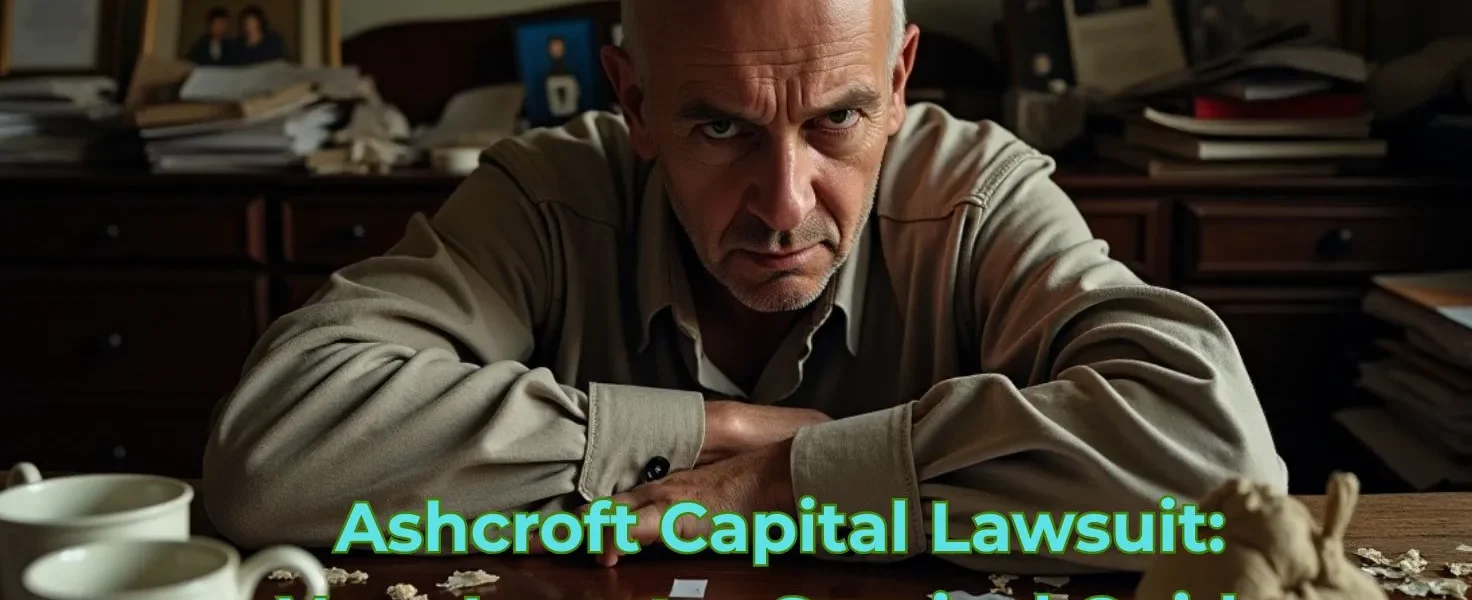Introduction:
The Ashcroft Capital lawsuit serves as a clear reminder that investing, although it can promise growth, also carries significant risks.
This major legal dispute has cast a dark cloud over Ashcroft Capital, prompting investors to question its transparency, financials, and alleged mismanagement.
This comprehensive guide will unravel this complicated legal mess, breaking down how it all affects you, the investor. We will provide you with straightforward, actionable advice to help guide you through this challenging situation. We’ll also uncover key allegations, show you where things stand in court today, and outline important next steps to ensure you are armed with critical information.
Understanding the Ashcroft Capital Lawsuit: A Detailed Overview

The Ashcroft Capital lawsuits have exposed a large multifamily real estate syndicator to intense scrutiny. To really understand that legal battle, though, you need to know something about the company’s history and what had transpired to bring about these legal wars.
What is Ashcroft Capital?
Ashcroft Capital was a major name in real estate syndication and was started by real estate professionals Joe Fairless and Frank Roessler.
Their business was based on purchasing and upgrading multifamily residential properties. Their aim: To produce cash flow for themselves and substantial returns for their many investors.
For years, the company had garnered attention for its aggressive expansion and what appeared to be a largely sleazy profit-making strategy in the frenzied world of real estate.
This drew massive funds from people looking into various types of investments.
The Genesis of the Ashcroft Capital Lawsuit: Why Are Investors Suing?
The Ashcroft Capital suit is based on allegations from investors who say they’ve lost money and been shut out of the process.
Characteristics vary from filing to filing, but typical complaints center on large discrepancies between expected returns and realized performance.
Furthermore, there are allegations of the failure to disclose significant risks. These are the types of things that Ashcroft Capital fraud allegations are based on.
The company, investors said, had deceived them with overly rosy projections.
They also allege that they provide a predictably accurate image of the investment health of the investments at the core. This led to a major dispute with Ashcroft Capital.
Key Parties Involved
This is the fight between Ashcroft Capital et al (Ashcroft Capital is the company and its founding principals Frank Roessler and Joe Fairless) and Joe Fairless, aka Ashcroft Capital LLC v. Joseph Fairless.
On the opposing side are the smattering of investors that sued. Although the names of the plaintiffs in these broader discussions are typically not released or are simply filed in class-action lawsuits, one named case is Cautero v. Ashcroft Capital.
Lawyers for the firm and the investors are now involved in complex evidence and arguments.
Key Allegations and Claims Against Ashcroft Capital lawsuit
The Ashcroft Capital case involves certain allegations that impugn the integrity and dedication to investor confidence under which the firm operates.
These accusations uncover what could be considered oversights that led to what some say was unnecessary financial hardship for many.
Allegations of Misrepresentation and Non-Disclosure
A central allegation is that Ashcroft Capital misrepresented its investment performance and associated risks. Initial estimates for property returns were overly optimistic, investors say.
They say those estimates did not factor in market volatility or operational constraints. Finally, Ashcroft Capital concealed hidden dangers.
They either downplayed or hid critical information that might have influenced investment decisions. Because no one communicated clearly and honestly, this forms a huge part of the lawsuits.
It decimated investor confidence and brought Ashcroft Capital’s transparency practices to the forefront.
Breach of Fiduciary Duty
All investment relationships are fiduciary. That’s because the investment manager must act exclusively in the best interest of their clients.
One of the central allegations against Ashcroft Capital is that it breached its fiduciary duty. That implies the company prioritized its interests, or those of its principals, over those of its investors.
For example, property management, financing, or fund allocation decisions may have been biased in favor of the firm, resulting in losses for investors.
Real Estate Investmen.t As a breach of fiduciary duty in real estate Business transactions can result in serious legal consequences.
Financial Mismanagement and Improper Use of Funds
Accusations also point to Ashcroft Capital’s financial misconduct and financial irregularity.
Complaints suggest that the company did not use sound investment strategies or handle funds as promised. Investors are also concerned about Ashcroft Capital’s misuse of capital.
They are inquiring about how Ashcroft Capital managed their funds and whether it adhered to their investment contracts. These allegations frequently cite a lack of accountability and financial mismanagement within the organization.
Ashcroft Capital Lawsuit Timeline & Current Status
Investors and other interested parties need to be informed about the progress of the Ashcroft Capital lawsuit. As with so many intricate legal fights, this matter is far from over.
Key Dates and Milestones
Public court records that are detailed and specific can be challenging to locate without the assistance of specialized legal services.
However, by late 2023, reports have emerged that Ashcroft is suspending payouts to investors. They had complained of headwinds such as increased rate caps on their loans.
This was a significant move, albeit temporary, by the firm, in part due to the prevailing market climate. It increased concerns among investors and probably led to lawsuits.
Other benchmarks are the filing of the original demands (whether for specific lawsuits like Cautero v. Ashcroft Capital or broader class actions), the preliminary hearings, and any ordered mediations or disclosures by court decree.
Recent Developments (as of July 2025)
The Ashcroft Capital lawsuit remains a contentious issue in the real estate investing community as of July 2025.
There are no major, definitive rulings or settlements that show in standard online searches in recent years. This implies that there isn’t a scheduled Ashcroft Capital lawsuit settlement payment.
The cases likely range from litigation to negotiation. To obtain the most accurate Ashcroft Capital lawsuit news, those interested should visit the individual courts’ dockets or pages for complete details.
Financial mismanagement: The allegations of financial mismanagement and the firm’s response to investor complaints remain in focus.
Potential Outcomes and Next Steps in the Legal Process
There are a few potential outcomes of the Ashcroft Capital lawsuit. It could lead to individual settlements through negotiation or a broader class-action suit that ends with a collective payout.
In the worst case, a trial process would follow with the result given by a court. Regulators, including the SEC, may impose regulatory penalties on companies for violating securities laws.
The final resolution will have far-reaching implications for the Ashcroft Capital lawsuit. These effects will impact the company directly, as well as the broader real estate investment community.
They might eventually yield a greater scrutiny and a new wariness among prospective investors.
Ashcroft Capital Lawsuit: What It Means for Your Investment
The Ashcroft Capital: lawsuit will have a direct financial and psychological impact on the investors. The effects are more than just financial, and extend to trust and future investment decisions.
Financial Ramifications for Affected Investors
For the investor, however, the primary concern is the potential for Ashcroft Capital investor losses. That could translate to a complete loss of principal, reduced or halted distributions, or delays getting capital back.
The company’s earlier move to suspend payouts put a direct strain on cash-strapped investors, leading many of them to struggle with liquidity.
Investors could also face other, more individual disputes, such as the Ashcroft Capital capital call dispute, where the firm requests more money from investors already wary of their initial investment.
Reputational Damage and Future Investment Climate
However, even beyond the financial toll, the litigation has caused significant damage to Ashcroft Capital’s brand reputation.
This not only sets the firm up for difficulty raising new capital, but also clouds its existing projects.
For the general real estate syndication market, cases like this will cause investors to become more cautious. It may slow down capital deployment across the industry, as due diligence becomes as intense.
Psychological Toll and Trust Issues
The psychological effect on investors can be devastating. Losing so much when a beloved company you invested heavily in, both your trust and money, faces a lawsuit is soul-crushing.
This often damages trust, which then makes future investment decisions much more difficult for the person who got screwed. It’s a reminder of how critical investor protection and the rigorous process of due diligence are.
Your Rights & Next Steps as an Ashcroft Capital Investor
If you are an Ashcroft Capital investor who invested in the ongoing lawsuit, knowing your options when it comes to seeking recourse is a high priority. The sooner you act, the more likely you are to recover your losses successfully.
Understanding Your Legal Rights
Harmful events present investors with several potential legal avenues. Depending on the nature and severity of the crime, an individual may file a lawsuit.
Or they might be eligible to participate in an Ashcroft Capital class action lawsuit. Class-action lawsuits pool the resources of multiple affected parties, making litigation more feasible.
Staying on top of Ashcroft Capital class action eligibility is crucial, as law firms are likely seeking to recoup their expenses.
Seeking Legal Counsel
Securities litigation is complex, so if you lack the necessary expertise, you will need assistance. We strongly recommend that you consult with an experienced securities litigation attorney or another attorney representing Ashcroft Capital in a class action.
These attorneys can evaluate your particular circumstance. They will be able to explain your rights and guide you through the complex legal process.
Find the Representation that best fits your needs. We recommend using a firm with an extensive track record in complex investment fraud cases.
How to Document Your Investment and Losses in the Ashcroft Capital Lawsuit
Regardless of whatever legal route you decide to pursue, you must document your investment meticulously. Gather all relevant paperwork, including:
Offering memorandums
Subscription agreements
Financial statements
Distribution records
All communications with Ashcroft Capital
This evidence will be crucial for establishing and proving your investment losses.
Staying Informed
The process is often not swift. You should always stay informed about Ashcroft Capital lawsuit updates through checking the original court dockets and other reliable legal news channels.
Your lawyer will keep you informed, but actively engaging with the knowledge will make you a more integral part of the process.
Lessons Learned from the Ashcroft Capital Lawsuit:

The Ashcroft Capital lawsuit serves as a stark reminder of the risks associated with investing, particularly in complex programs such as real estate syndications.
Learning from this episode would benefit both existing and future investors by helping them avoid losing their hard-earned capital.
Enhanced Due Diligence Practices
Due diligence is the foundation of investor protection. Don’t rely on marketing materials or a sponsor’s projections. Instead, perform your own thorough Ashcroft Capital due diligence checklist.
This should include:
Doing an in-depth analysis of offering docs, sponsors with track records, and financials.
Carefully looking into the sponsor’s (and team’s) experience (e.g., Frank Roessler, Joe Fairless).
For an independent confirmation of the value of properties and market analysis.
Knowing the compensation system and possible conflicts of interest. Traveling and Health are using similar structures by the end of the year.
Look for Ashcroft Capital red flags and bad review warnings for due diligence. These general issues include overly aggressive forecasting, lack of transparency in reporting, or pressure to invest fast.
The Importance of Transparency and Communication
Consider the sponsor’s commitment to due diligence before making an investment. Seek clear, frequent, and detailed communication on the investment’s performance, challenges, and any significant operational changes. Silence or an unwillingness to offer updates when the question is asked can be a red flag.
Diversification and Risk Management
Do not ever bet the whole farm on a given position. Spreading your investments across different asset classes, industries, and sponsors can help minimize the impact of a single weak investment or failure.
And remember, while real estate investment can be quite lucrative, it holds its risks. You’ll need to mitigate these risks effectively.
Conclusion
The Ashcroft Capital lawsuit serves as a significant example of the risks associated with real estate syndications and private investments.
It highlights the importance of thorough due diligence, robust investor protection, and complete transparency from investment companies.
As the implications of the Ashcroft Capital lawsuit unfold, this case proves to teach significant lessons for the entire finance industry.
If you’re an affected investor, act quickly. Speak to an experienced securities litigator to learn what your legal options are.
For all investors, from the most inexperienced to the most seasoned, let this be a case that prompts an extra dose of vigilance.
FAQs
What is the Ashcroft Capital suit?
In plain English, it is a lawsuit by investors against a real estate syndication company, alleging that the sponsor misrepresented to them, mismanaged their investment, and breached their fiduciary duty.
Who are the primary players in the Ashcroft Capital lawsuit?
The primary players are Ashcroft Capital, the real estate investment firm, and its founders, Joe Fairless and Frank Roessler, as well as the investors who have sued them.
What were the central claims made against Ashcroft Capital?
Among the specific claims are that the churchmen misrepresented returns for investors, failed to disclose risks, and violated their fiduciary responsibilities by mismanaging the funds.
As of now, what happened with the Ashcroft Capital lawsuit?
Conclusion: The Ashcroft Capital litigation is pending, and there will likely be cases at various stages of litigation or negotiation, with no announced settlement as of July 2025.
What are Ashcroft Capital investors supposed to do now?
Ashcroft Capital Shareholders Holders of Ashcroft Capital should collect all information and documents regarding the investment and consult with a skilled securities attorney if they have potential claims for recovery against their Brokerage Firm.








